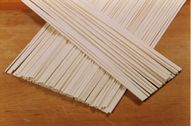JAPANESE COOKBOOK FOR KIDS (Page 1 of 5) |
|
Part 6: Soba
and Udon
|
|
The
Story of Soba and Udon
Soba is said to have originated in China and been brought to Japan toward the end of the Jomon period (10,000 BC to 300 BC). There are also records of buckwheat flour, from which soba noodles are made, being grown to help fight a famine in the Nara period (710 to 794). Buckwheat is a highly nutritious grain, especially rich in vitamin B. The flour produced by extracting the inside of the grain is white, but if the skin is also used, the flour takes on a unique flavor and turns a grayish color. This kind of flour is usually used to make the soba that people love so much.
|
|
"Hi, I'm Mao. I'm going to try to show you how to make soba and udon." |
|
|
 Soba
and udon are two types of noodles that Japanese people love very
much. They can both be eaten either hot or cold, and there are many
different varieties in different regions of Japan.
Soba
and udon are two types of noodles that Japanese people love very
much. They can both be eaten either hot or cold, and there are many
different varieties in different regions of Japan.  Udon
noodles are made by mixing flour with lightly salted water, then kneading,
stretching, and cutting the dough into thin strips. It is said that
udon also came to Japan from China around the Nara period. One
of the interesting things about udon is that the thickness and
hardness of the noodles varies from region to region. For example, noodles
called kishimen and hoto are flat and wide, while those
known as somen are very thin. There are so many different styles
that you can go to almost any region in Japan and taste that area's
special udon.
Udon
noodles are made by mixing flour with lightly salted water, then kneading,
stretching, and cutting the dough into thin strips. It is said that
udon also came to Japan from China around the Nara period. One
of the interesting things about udon is that the thickness and
hardness of the noodles varies from region to region. For example, noodles
called kishimen and hoto are flat and wide, while those
known as somen are very thin. There are so many different styles
that you can go to almost any region in Japan and taste that area's
special udon.